Earlier this year, I was at a posh party with my husband. Shortly after arriving, my husband went white, and almost fainted. We took him outside and put his feet up on a bench. Fortunately, there was a doctor at the party who stayed with us until my husband was back on his feet.
It was quite a scary experience, and it happens because my husband has high blood pressure, which is controlled with medication. Unfortunately, if his blood pressure ever drops (for example, after going up a steep flight of stairs at a hot party), the medication prevents it from rising fast enough to compensate, and he has a ‘funny turn’. It’s not serious, but it makes me very aware of the possible problems associated with abnormal blood pressure.
My husband isn’t alone. It’s estimated that 16 million people in the UK suffer from high blood pressure, otherwise known as hypertension. Some, like my husband, inherit it, and there’s not much we can do about that. But many others develop hypertension as a result of inappropriate lifestyle choices. If that’s you, there’s a great deal you can do to support your blood pressure with healthier alternatives.
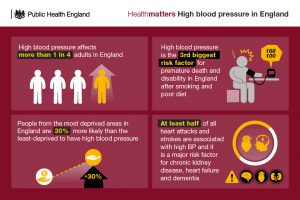
Blood pressure facts and figures (UK)
This week is ‘know your numbers week’, a national drive for people to get their blood pressure measured and know what their numbers are. I think this is a great idea, but only if you understand what the numbers mean, and what you can do about them. So, today I’m going to explain what blood pressure is, and what the numbers represent. In my next post, I’ll talk about what you can do to look after your blood pressure.
What is blood pressure and why does it matter?
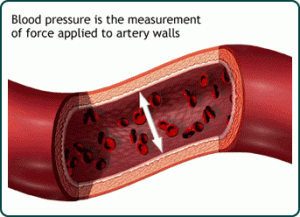 As your blood is pumped round the body, it puts pressure on the walls of the vessels it travels in; your arteries, veins and capillaries. Obviously, the pressure is different in each of the vessels, according to its size, function and where it is in the body. The pressure that we measure is the pressure your blood puts on the largest arteries in the heart as it travels through them. This pressure is affected by:
As your blood is pumped round the body, it puts pressure on the walls of the vessels it travels in; your arteries, veins and capillaries. Obviously, the pressure is different in each of the vessels, according to its size, function and where it is in the body. The pressure that we measure is the pressure your blood puts on the largest arteries in the heart as it travels through them. This pressure is affected by:
-
How ‘stretchy’ these arteries are
-
How much blood is flowing through them at a particular time.
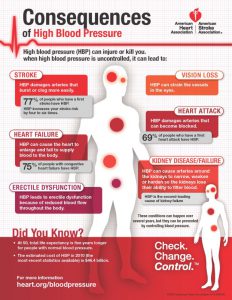 Blood pressure is important, because high blood pressure puts you at increased risk of heart attacks, strokes and kidney failure. High blood pressure may also be a symptom of a problem with your arteries; if they become less ‘stretchy’, or develop an obstruction, the pressure in them will be higher. Low blood pressure (hypotension) is not usually a problem, but it can cause some older people to feel dizzy when they get up after sitting. It can also be a symptom of a nutritional deficiency such as anaemia, so if you develop low blood pressure, take a look at your diet.
Blood pressure is important, because high blood pressure puts you at increased risk of heart attacks, strokes and kidney failure. High blood pressure may also be a symptom of a problem with your arteries; if they become less ‘stretchy’, or develop an obstruction, the pressure in them will be higher. Low blood pressure (hypotension) is not usually a problem, but it can cause some older people to feel dizzy when they get up after sitting. It can also be a symptom of a nutritional deficiency such as anaemia, so if you develop low blood pressure, take a look at your diet.
What do your numbers mean?
If you’ve ever looked at a blood pressure monitor, or watched a hospital show where they measure a patient’s blood pressure, you’ll notice that two numbers are mentioned; a higher number over a lower number.
The top number, which is the larger of the two, is called systolic blood pressure. It’s the pressure created when the heart contracts, pushing blood through the arteries. An ideal systolic blood pressure for a healthy adult is 80-120 (or 100-120 depending on what you read). If your systolic pressure is between 121 and 140, you don’t technically have high blood pressure, but you may be on the way there, so it’s a good time to take action. This stage is known as prehypertension. In case you’re wondering, blood pressure is measured in millimetres of mercury (mm Hg), because blood pressure is measured by the amount that it causes a column of mercury to rise.
The bottom number, which is the smaller one, is called diastolic blood pressure. This is a measurement of the pressure in the arteries between beats, when the heart is at rest. A normal diastolic blood pressure is between 70 and 80.
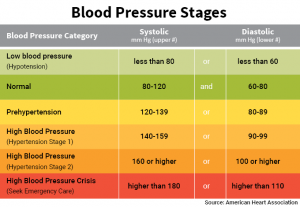
What are your numbers, and what do they mean for you?
Data from the most recent studies suggests that systolic blood pressure (the larger number) is most likely to determine your risk of heart disease if you are over 50, so this is the one to watch. If your blood pressure is greater or equal to 160/100 your doctor will advise treatment. If your blood pressure is 140/90 or higher, the action you and your doctor will take will depend on your other risk factors.
What can cause high blood pressure?
There are many factors that can contribute to high blood pressure. The most common include:
Genes – some people, like my husband, inherit high blood pressure. Some ethnic groups, such as people of Asian origin, are also at higher risk.
Diet – a diet high in salt has been associated with high blood pressure, as have deficiencies in potassium, calcium and magnesium. A diet rich in fruit and vegetables may be associated with lower blood pressure. Higher alcohol intake may also contribute to high blood pressure. A diet that contributes to obesity may also be an issue, as obese people tend to be more likely to have high blood pressure than people of a normal weight.
Age – people over 40 are more likely to develop high blood pressure. Over 50% of people over 60 may suffer from high blood pressure as a result of their arteries becoming stiffer.
Smoking – the nicotine in cigarettes causes blood vessels to constrict, raising the pressure inside them.
Stress – stress can temporarily raise blood pressure as the heart pumps harder in response to an emergency. This accounts for ‘white coat syndrome’. When you go to the doctor, you get nervous, so when your blood pressure is measured it’s often high. This happened to me once, and as soon as I taught myself to relax, the measurement was normal. If it happens to you, your doctor may suggest wearing a blood pressure monitor for a few days, to measure your blood pressure when you’re not under stress.
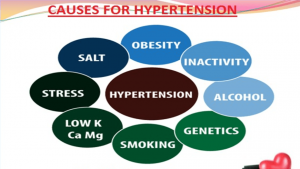
Are any of these risk factors for you?
Now that you know what your numbers mean, you might like to know what you can do about them. In my next post I’ll be sharing the lifestyle measures you can take to support healthy blood pressure. I’ll see you then!
I’d love to hear whether this post was useful to you, and what else you’d like me to write about. Please leave a comment below, or get in touch.
If you’d like to know more about how to take care of your blood pressure with lifestyle measures, I’m looking for 12 people to join my 21-day course. Learn the best way to eat (according to clinical trials), the most helpful forms of physical activity, find out more about what blood pressure is and how to talk to your doctor about it, and much more. Welcome week is w/c 14 Septmeber, so find out more details and join us here: https://nutritionwithsusannah.lpages.co/reduce-the-pressure/
 As your blood is pumped round the body, it puts pressure on the walls of the vessels it travels in; your arteries, veins and capillaries. Obviously, the pressure is different in each of the vessels, according to its size, function and where it is in the body. The pressure that we measure is the pressure your blood puts on the largest arteries in the heart as it travels through them. This pressure is affected by:
As your blood is pumped round the body, it puts pressure on the walls of the vessels it travels in; your arteries, veins and capillaries. Obviously, the pressure is different in each of the vessels, according to its size, function and where it is in the body. The pressure that we measure is the pressure your blood puts on the largest arteries in the heart as it travels through them. This pressure is affected by:




2 comments
wellnesshorizon
August 31, 2018 at 8:06 pm (UTC 0) Link to this comment
It was a very helpful post for everybody.we want more tutorial like this.
How to reduce high blood pressure naturally at home
Thank you so much for upload this post!
Patricia
May 26, 2019 at 8:43 am (UTC 0) Link to this comment
Follow doctor’s recommendations, each case different Prehypertension vs hypertension epidemiology, causes, essential why lower?